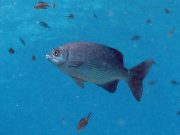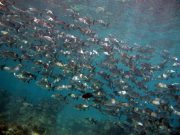Diving with Sea Chubs
Lanta Marine Life | kyphosidae
The 54 species of sea chubs have short heads, blunt snouts, and small mouths. They have strong, close-set teeth which are strangely shaped like hockey sticks, with two species often spotted on Koh Lanta dive trips.
There is a single, continuous dorsal fin which can be folded into a scaly groove. They have a forked tail and are usually a drab colour and may have some bluish or yellowish stripes.
Sea chubs are largely herbivorous, feeding mainly on algae, with others being carnivorous, feeding on invertebrates found on the seafloor, rocks and corals.
Very large schools can form in shallow rocky and coral reef areas for feeding, and we sometimes see this around the Koh Haa islands.
Members of this family sometimes gather in large numbers for pelagic spawning.
2 species found on this page:
Topsail Drummer
(Kyphosus cinerascens)
The Topsail Drummer, Kyphosus cinerascens, is found in small to large schools in shallower reef areas where there is abundant algae growth. Their diet consists of invertebrates, algae and seaweed. When feeding as a large school, they can quickly overwhelm territorial damselfishes and surgeonfishes.

Kyphosus cinerascens @ Koh Haa
The Topsail Drummer is typically a silvery-grey fish with fine horizontal lines along the side, a pale stripe on the cheek, and a large tail fin.
The fish has a small bump over the eyes and a more pointed, downward angled snout that other fish of the same genus.
The dorsal fin runs the length of the fish and appears 'connected' to the anal fin.
The Topsail Drummer is poisonous to humans and should not be eaten.
Lowfin Drummer
(Kyphosus vaigiensis)

Pair of Kyphosus vaigiensis @ Koh Haa
The Lowfin Drummer has two phases, the first having a silvery grey body with narrow bronze stripes, and the second phase with a darker body and numerous white spots. The Lowfin Drummer can rapidly change phase.
The rear dorsal fin is not elevated (as in the Topsail Drummer) and the outer edge of the anal fin is diagonal, aligning with the outer edge of the upper tail lobe.
The Lowfin Drummer grows to 45 cm and forms small to very large groups in rocky shore areas or above reef flats.
Diving with Sea Chubs around Koh Lanta
Scuba Diving & Snorkel Trips
If you'd love a chance to spot Sea Chubs on one of our daily high season diving trips from Koh Lanta then send us an email to info@diveandrelax.com.
Join our high season speedboat dive trips to some of Thailand's best dive sites and enjoy small groups, short journey times, with a focus on great personal service, safety and fun.
Not yet a certified diver? Learn to Scuba Dive on Koh Lanta with the 3 day SSI Open Water Diver course.
Book online to save 10% on dive trips and scuba courses on Koh Lanta.
Find Out More
Indo-Pacific Marine Life Guides
- Allen, G., Steene, R., Humann, P., DeLoach, N. (2003) Reef Fish Identification, Tropical Pacific. Jacksonville, FL., USA: New World Publications, Inc., ISBN 1-878348-36-1.
- Humann, P., DeLoach, N., (2010) Reef Creature Identification, Tropical Pacific. Jacksonville, FL., USA: New World Publications Inc., ISBN 978-1-878348-44-9
- Debelius, H. (2013) Indian Ocean Reef Guide. Frankfurt, Germany: IKAN - Unterwasserarchiv, ISBN 978-3-939767-52-7.
- Debelius, H. (2004) Nudibranchs and Sea Snails, Indo-Pacific Field Guide. Frankfurt, Germany: IKAN - Unterwasserarchiv, ISBN 3-925919-51-1
- Erhardt, H., Knop, D. (2015) Corals Indo-Pacific Field Guide. Frankfurt, Germany: IKAN - Unterwasserarchiv, ISBN 3-925919-69-4.
- Veron J.E.N., Stafford-Smith M.G., Turak E. and DeVantier L.M. (2016). Corals of the World


